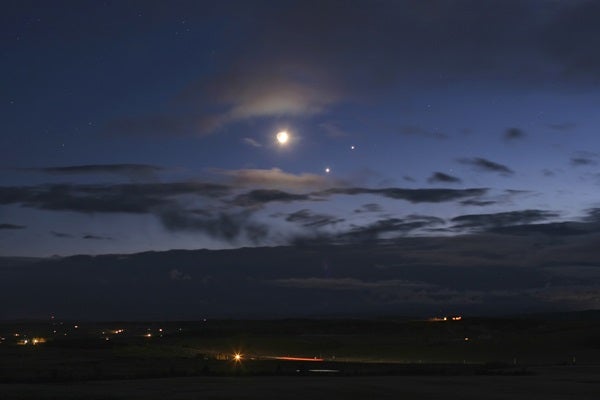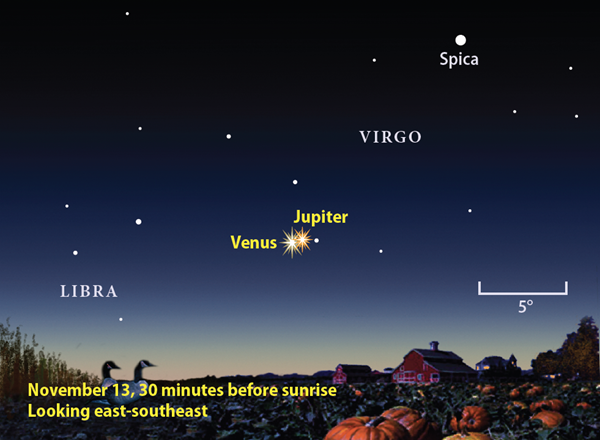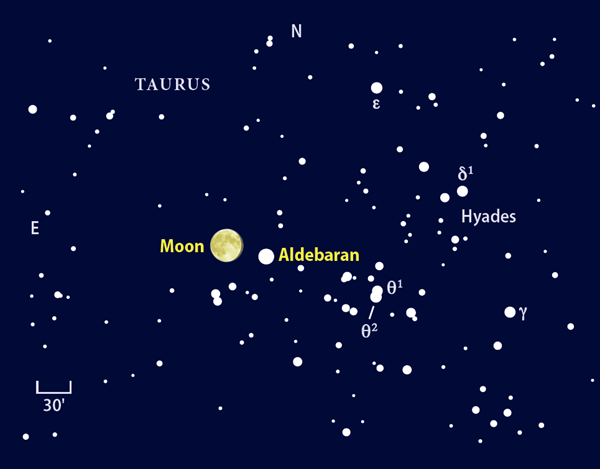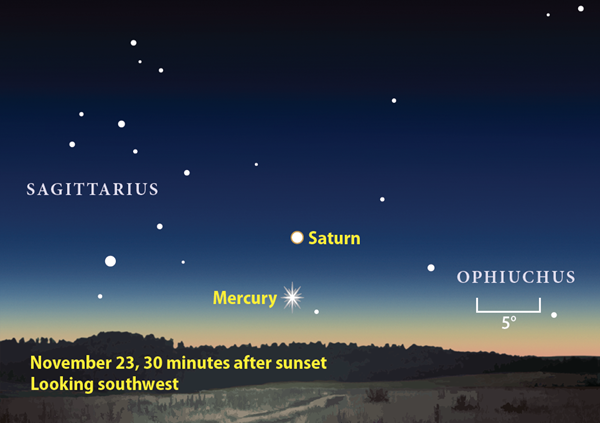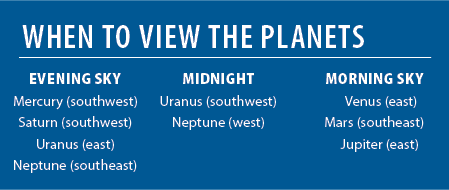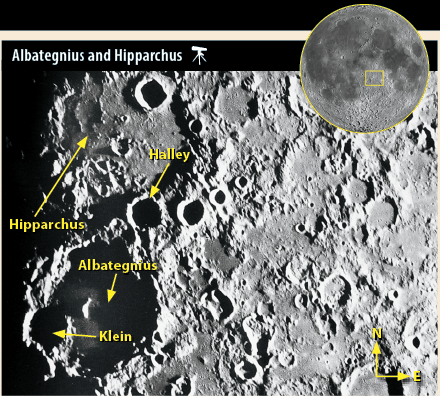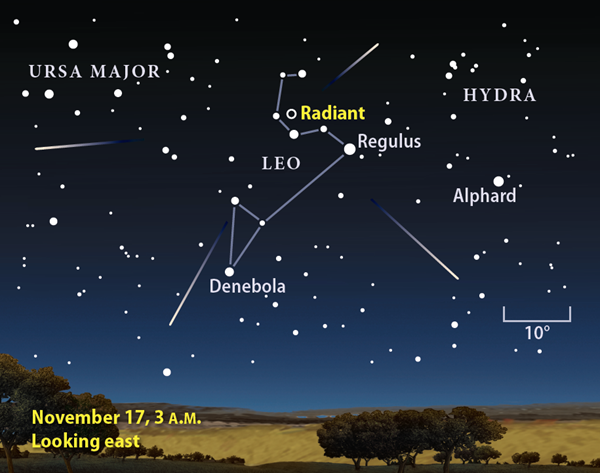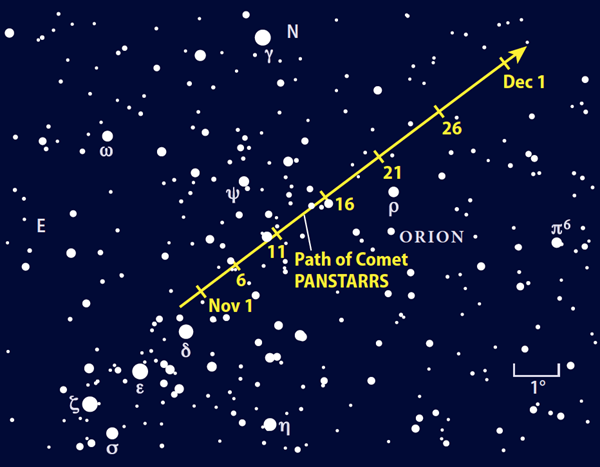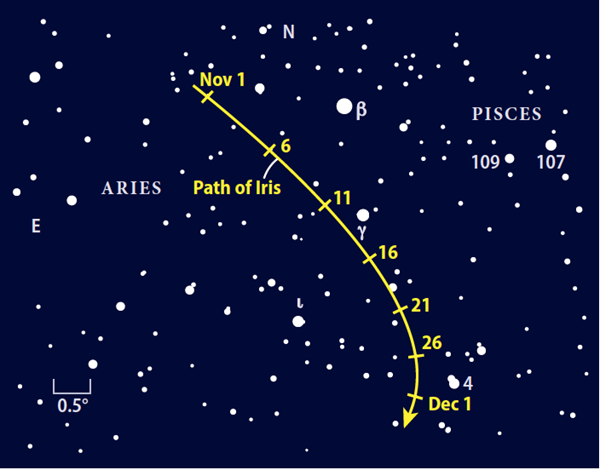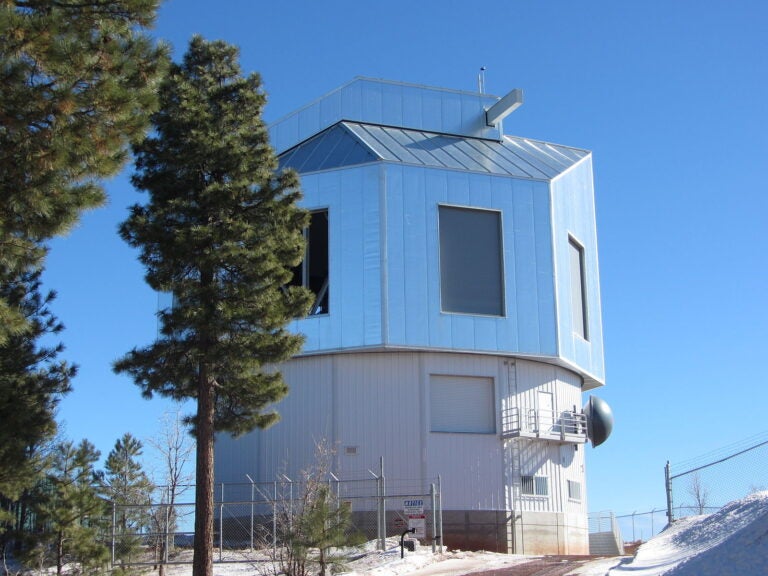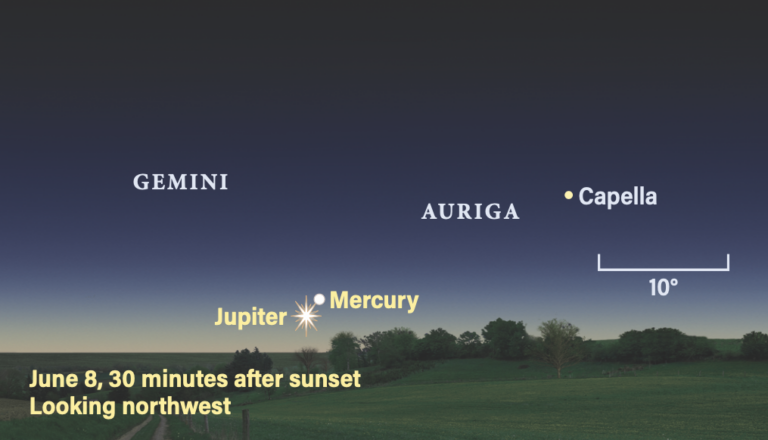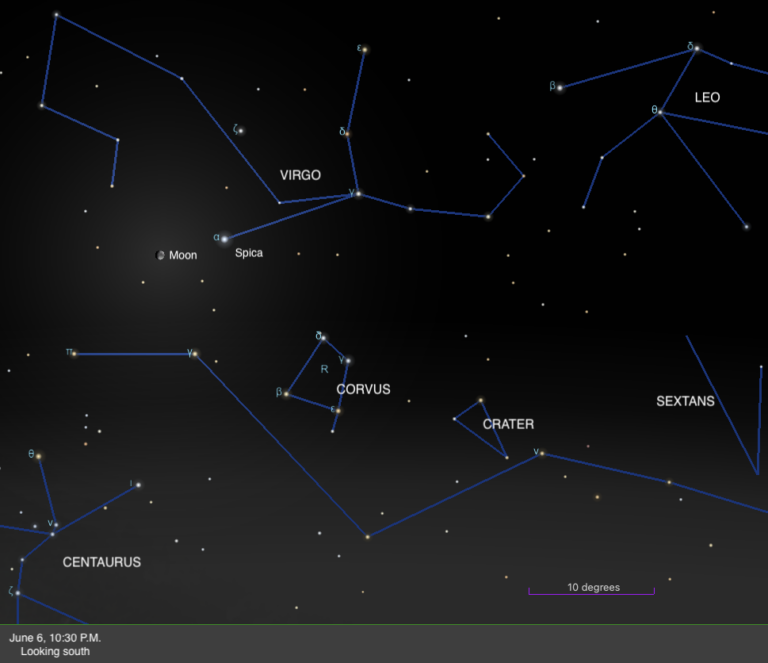The evening sky boasts appearances from the other four planets. Mercury and Saturn shine brightly in the southwestern sky after sunset, while Uranus and Neptune reach their peak altitudes before midnight. All four make tempting targets through binoculars and telescopes.
Let’s begin our night sky tour in the southwest during evening twilight. Mercury comes into view starting in mid-November for observers at mid-northern latitudes. On the 15th, it stands 5° above the horizon a half-hour after sunset. At magnitude –0.3, the planet is bright enough to pierce the twilight glow. If you can’t spot it right away, binoculars gather enough extra light to show it easily.
The view of Mercury improves a bit during the next 10 days. The innermost planet reaches greatest elongation November 23, when it lies 22° east of the Sun and appears 7° high 30 minutes after sundown. Mercury also shines 0.1 magnitude brighter than it did on the 15th. Although the inner world fades to magnitude –0.2 by the end of the month, it manages to maintain its altitude.
If you target Mercury through a telescope, you’ll see its appearance change rapidly during November’s second half. On the 15th, the rocky world’s disk measures 5.7″ across and is 80 percent lit. But the inner planet races around the Sun faster than any other, and this motion brings it closer to Earth in the following weeks. By the 30th, Mercury spans 7.6″ and the Sun illuminates 44 percent of its Earth-facing hemisphere.
A scan for Mercury through binoculars in November’s final days also will reveal the fainter glow of Saturn. This is the tail end of the ringed planet’s evening appearance, however, and it will be far easier to spot early in the month. On the 1st, Saturn hangs 15° above the southwestern horizon an hour after sunset, and it is still 10° high at twilight’s close.
Of course, the best way to enjoy the ringed planet is through a telescope. The finest views come early in the month when it lies highest. On the 1st, Saturn’s disk appears 15″ across while the rings span 35″ and tilt 27° to our line of sight.
You’ll also want to catch the waxing crescent Moon when it climbs past Mercury and Saturn. It might be hard to glimpse the one-day-old Moon on November 19, when it lies 8° to Mercury’s right. You’ll have an easier time the following evening, when a significantly fatter crescent stands 3° to Saturn’s upper right and 8° above Mercury. The planets themselves have a close conjunction the evening of the 27th, when Mercury passes 3° due south of Saturn.
While Mercury and Saturn appear low and bright on November evenings, Uranus and Neptune are high and dim. Neptune climbs highest in the south around 7 p.m. local time at midmonth, when it stands nearly halfway to the zenith. The ice giant world glows at magnitude 7.9 and shows up nicely through binoculars against the backdrop of Aquarius the Water-bearer.
Neptune’s westward trek relative to the stars comes to a halt November 22, but its motion is slow and it appears nearly stationary all month. To find it, locate 4th-magnitude Lambda (λ) Aquarii. Neptune spends November just 0.6° south of this star.
No background star of similar brightness lies in this vicinity, so you shouldn’t have much trouble identifying it through binoculars. If you’re unsure, target the possible planet through a telescope. Only Neptune shows a disk, which appears 2.3″ across and boasts a subtle blue-gray color.
Uranus resides one constellation east of Neptune, in the similarly indistinct Pisces the Fish. But Uranus glows at magnitude 5.7, some eight times brighter than its ice giant sibling, and is far easier to spot through binoculars. In fact, sharp-eyed observers can glimpse it with the naked eye under a dark sky.
The world appears in the east as darkness falls and reaches its peak around 10 p.m. local time in mid-November. It then lies two-thirds of the way to the zenith and in prime viewing position.
Uranus lies midway between these conspicuous stars. Scan the area through binoculars until you find magnitude 4.3 Omicron (ο) Piscium, the brightest star in this part of Pisces. Uranus stands 2.3° west of Omicron on November 1. The planet’s motion relative to the background carries it to a position 3.2° west of the star by month’s end.
Although Uranus is the brightest object in this area, several slightly fainter stars share the same binocular field. To confirm a sighting, aim a scope toward your suspect. Uranus displays a 3.7″-diameter disk with a distinct blue-green hue.
As Uranus dips low in the west, Mars pokes above the eastern horizon. The Red Planet rises nearly three hours before the Sun on November 1 and almost four hours before sunrise on the 30th. Though Mars appears bright at magnitude 1.8, it stands out more for its distinctive ruddy color.
The planet tracks eastward across Virgo the Maiden this month. It starts November 1.0° southeast of magnitude 3.9 Eta (η) Virginis, passes 1.8° south of magnitude 2.8 Gamma Vir on the 9th, and 3.3° north of magnitude 1.0 Spica (Alpha Vir) on the 28th. Notice the stark color contrast between the orange-red planet and Virgo’s blue-white luminary.
The view of Mars through a telescope remains disappointing, however. With a diameter of only 4″, it shows no detail. But the planet’s fortune will improve dramatically in 2018. By spring, Mars will shine at magnitude –1 and span 10″. And its July opposition will be the best in 15 years.
Although Venus slips deeper into twilight as the month progresses, that’s when it has its finest moments. Jupiter passed on the far side of the Sun in late October and is now climbing rapidly into the predawn sky. The planets meet each other November 13 in the finest planetary conjunction of 2017. The two rise in the east-southeast some 70 minutes before sunrise and climb 5° high a half-hour later. Venus, still glowing at magnitude –3.9, appears just 0.3° to the left of magnitude –1.7 Jupiter. A telescope shows both in a single field. Venus spans 10″ and appears nearly full, while Jupiter appears three times bigger and at the center of an entourage of four bright moons.
Three mornings later, on the 16th, a stunning sight awaits early risers. Jupiter now stands 3° above Venus while a slender crescent Moon appears 6° above the giant planet.
By the end of November, Venus disappears into the Sun’s glare. But Jupiter improves markedly, rising in a dark sky more than two hours before the Sun and climbing nearly 15° high an hour before sunup. It appears among the background stars of Libra the Scales.
Observers in eastern and central North America are in for a surprise the evening of November 5. Although the waning gibbous Moon lies among the background stars of Taurus the Bull, constellation’s brightest star will be absent — Luna is blocking 1st-magnitude Aldebaran from view. Observers should target the Moon’s dark limb through their telescopes and try to view the star as it suddenly reappears. To find the precise time when Aldebaran returns to view for your location, visit www.lunar-occultations.com/iota/bstar/bstar.
The main reason lunar observers keep coming back for more is that the Moon’s appearance constantly changes. The play of sunlight and shadow near the terminator — the dividing line between day and night on the lunar surface — transforms our perspective from day to day and often from hour to hour. A prominent crater boasting fantastic shadows one evening can nearly disappear the next under a higher Sun angle.
Two large impact craters stand out along the terminator on the waxing crescent Moon the evening of November 25. The southern and more rugged of the two is Albategnius, named after the ninth-century Arabian astronomer and prince al-Battani. A smaller impactor created the earring-like crater Klein on its western rim. The long shadows cast by Albategnius’ tall rim and central peak retreat fast enough that you can notice a change in as little as 30 minutes. Also note the fairly smooth lava plain on the crater’s floor.
The highly battered rim of Hipparchus lies just to the north, a mute testament to its greater age. Even the lava-flooded floor is clearly older, boasting many more features than its neighbor. Hipparchus nearly disappears a couple of nights later because its lower and rounder slopes don’t cast shadows under the higher Sun angle.
Scientists named this crater for Hipparchus, a Greek astronomer whose second-century b.c. star catalog marked a significant milestone in science history. It enabled British scientist Edmond Halley to demonstrate, more than 1,800 years later, that stars move relative to one another. And just as Halley built upon Hipparchus’ work, the lunar crater Halley stands on the broad shoulders of his predecessor’s crater.
New Moon arrives November 18, just one day after the peak of the annual Leonid meteor shower. With no Moon to interfere, observers under dark skies can expect to see up to 10 meteors per hour. The “shooting stars” appear to radiate from a point in the Sickle asterism of the constellation Leo the Lion. This region rises in late evening and climbs high in the southeast before dawn. Prime viewing occurs between 3 a.m. local time and the start of twilight some two hours later.
The meteors blaze into Earth’s atmosphere at a sizzling 44 miles per second, the fastest of any shower meteors. The high speeds mean they produce a greater percentage of fireballs than most showers.
Comet PANSTARRS (C/2016 R2) likely began its journey from the distant Oort Cloud tens of thousands of years ago. Its long trek now nearly complete, PANSTARRS should glow around 10th or 11th magnitude in November, bringing it within range of a 4-inch telescope under a dark sky.
C/2016 R2 will be a delicate sight silhouetted against the picturesque backdrop of the constellation Orion the Hunter. The rich star fields here will help you zero in on the comet’s position, and the lack of background galaxies will make it fairly easy to identity the interloper.
PANSTARRS begins the month just 1° north-northwest of magnitude 2.2 Mintaka (Delta [δ] Orionis), the westernmost star in Orion’s Belt. It heads northwest from there toward the Hunter’s Shield, passing 1° north of magnitude 4.5 Rho (ρ) Ori at the start of November’s fourth week. This region climbs highest after midnight, so the best views will come in mid- and late November when the Moon is absent from the morning sky.
Astronomers expect the comet to span only a couple of arcminutes, making it visually similar to one of the smaller galaxies in the Virgo Cluster. You might not see it at low power, so bump up the magnification to 100x or more and take your time locating the cotton ball, letting your eyes adjust to the darker field.
Comet PANSTARRS will take a long time to cross Earth’s northern sky because it is still three times farther from the Sun than Earth is. Even at its closest point to our star in May 2018, it will reside well beyond Mars’ orbital distance.
Asteroid 7 Iris reached opposition in late October, and it begins this month at its peak brightness of magnitude 6.9. Although it fades to magnitude 7.7 by November’s close, Iris remains bright enough to pick up through binoculars from the suburbs. It should be a snap to find as it climbs high in the late-evening sky.
The asteroid resides in Aries the Ram. This constellation appears halfway to the zenith in the eastern sky once darkness settles in and climbs highest in the south around 10 p.m. local time. Iris executes a gentle arc south of Aries’ brightest stars, limiting itself to a single binocular field for the entire month.
You can track the asteroid’s nightly position with the chart below, which shows stars to magnitude 9.5. The space rock begins the month 2° east of magnitude 2.7 Beta (β) Arietis before heading southwest toward magnitude 3.9 Gamma (γ) Ari. Iris slides within 0.4° of Gamma — a fine double star — from November 12–15. During the month’s final few days, the asteroid passes 0.5° east of the magnitude 5.9 star 4 Ari.
Iris glows about as bright as it can this month. It won’t reach 7th magnitude again until 2028.

